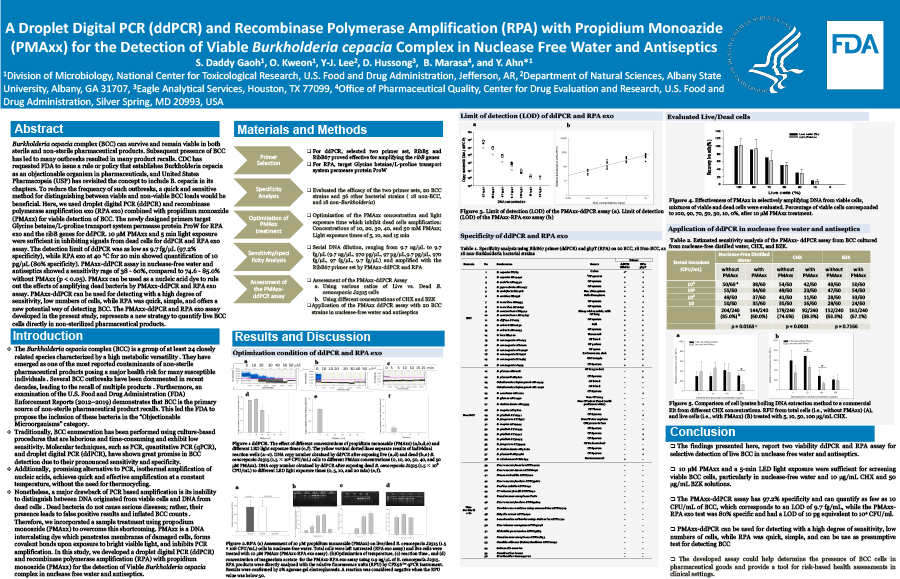2023 FDA Science Forum
A Droplet Digital PCR (ddPCR) and Recombinase Polymerase Amplification (RPA) with Propidium Monoazide (PMAxx) for the Detection of Viable Burkholderia cepacia Complex in Nuclease Free Water and Antiseptics
- Authors:
- Center:
-
Contributing OfficeNational Center for Toxicological Research
Abstract
Burkholderia cepacia complex (BCC) can survive and remain viable in both sterile and non-sterile pharmaceutical products. Subsequent presence of BCC has led to many outbreaks resulted in many product recalls. CDC has requested FDA to issue a rule or policy that establishes Burkholderia cepacia as an objectionable organism in pharmaceuticals, and United States Pharmacopeia (USP) has revisited the concept to include B. cepacia in its chapters. To reduce the frequency of such outbreaks, a quick and sensitive method for distinguishing between viable and non-viable BCC loads would be beneficial. Here, we used droplet digital PCR (ddPCR) and recombinase polymerase amplification exo (RPA exo) combined with propidium monoazide (PMAxx) for viable detection of BCC. The newly designed primers target Glycine betaine/L-proline transport system permease protein ProW for RPA exo and the ribB genes for ddPCR. 10 µM PMAxx and 5 min light exposure were sufficient in inhibiting signals from dead cells for ddPCR and RPA exo assay. The detection limit of ddPCR was as low as 9.7 fg/μL (97.2% specificity), while RPA exo at 40 °C for 20 min showed quantification of 10 pg/µL (80% specificity). PMAxx-ddPCR assay in nuclease-free water and antiseptics showed a sensitivity rage of 38 - 60%, compared to 74.6 - 85.0% without PMAxx (p < 0.05). PMAxx can be used as a nucleic acid dye to rule out the effects of amplifying dead bacteria by PMAxx-ddPCR and RPA exo assay. PMAxx-ddPCR can be used for detecting with a high degree of sensitivity, low numbers of cells, while RPA was quick, simple, and offers a new potential way of detecting BCC. The PMAxx-ddPCR and PMAxx-RPA exo assay developed in the present study, represents a new strategy to quantify live BCC cells directly in non-sterilized pharmaceutical products.

